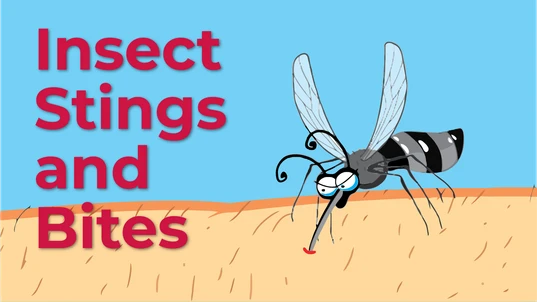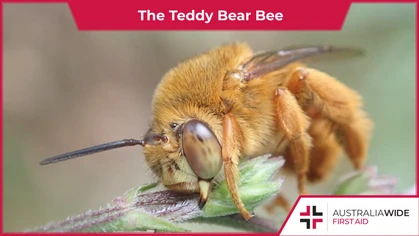Identify and Treat Insect Bites and Stings

Bites and Stings

If cold or fever like symptoms follow a bite from a mosquito, the person should seek medical attention immediately
Identify and Treat Insect Bites and Stings First Aid for Insect Bites First aid treatment for insect bites or stings changes on a case-by-case basis and depends on the type of insect that inflicted the bite.Not all bites or stings have the same symptoms
It can be difficult to tell if an insect bite or sting will turn into something more insidious. A good start would be knowing the type of insect involved. For most people, stings and bites from bees, ants, mosquitoes, flies and wasps, will not too worrisome. Symptoms will generally involve redness, itchiness, mild inflammation or pain. However, this is not always the case… Allergic reaction is the worry. This can result in severe symptoms, ranging from hives and swelling of the throat, face and lips, to shock, abdominal cramping, nausea and vomiting, through to breathing problems. Allergic reaction from an insect bite or sting can quickly become life-threatening.Insect Sting Symptoms
After penetrating the skin, an insect sting generally leaves behind saliva, venom, even faeces. It's also common for the “stinger” to be left behind. Whether it's venomous, or not, is the question… Symptoms caused by an insect sting:- Extreme burning sensation at the sting site
- Skin redness around the site of the sting
- Pain – mild through to intense &ndash often fading after an hour or two
- Swelling around the sting site. In more severe cases and allergic reactions, swelling can spread to affect a larger area of the body, such as an entire limb
- With allergic reactions, blisters can also form on the skin
- More extreme allergic reactions can result in anaphylaxis
- Pain from a sting rarely lasts more than a day or two, however, the area may feel tender for several days after
The stings that most commonly cause anaphylaxis are bee and wasp stings. Wasps are far more aggressive than bees. While outdoors, it pays to stay out of harm's way and keep an eye on open food and drink containers. Wasps are drawn to food and sugary drinks.
First Aid for a Bee or Wasp Sting
Do not use tweezers to pull out a bee's stinger. This would serve to squeeze more venom from the sack attached to it. Instead try to coax the stinger out with a swift motion, using the edge of a credit card or a fingernail. Removing the stinger so quickly and without pinching, avoids the release of more venom. With the stinger removed, wash the region with soap and water. Wasps don't generally leave their stinger behind. For milder reactions from a wasp sting, apply a cold pack and a soothing cream. Oral antihistamines can be taken to help calm itching sensations. If anaphylaxis occurs after a bee or wasp sting, an epinephrine auto injector should be used. Where no epinephrine is available and in all cases other than for mild anaphylactic symptoms, an ambulance should be called without delay. If a hospital is close by, take the victim directly to the emergency ward.First aid for a Scorpion, Centipede or Caterpillar Sting
For scorpion and centipede stings, use an ice pack to reduce inflammation, before cleaning the wound with either antiseptic or soap and water. The victim may need analgesia for pain relief. For caterpillar stings, use tweezers to pull out larger hairs, and adhesive tape to remove finer hairs.First aid for Mosquito Bites
Wash the mosquito bite site with soap and water or apply an antiseptic. A cold pack can help relieve swelling and reduce symptoms. If cold or fever like symptoms follow from the mosquito bite, the person should seek medical attention immediately.First aid for Tick Bites
Ticks embed themselves quite firmly in their host. Care needs to be taken when trying to remove them. Tweezers or fingernails can easily result in pinching the tick, which will result in squeezing more of the allergen into the host's body. Instead, freeze the tick, using an ether-based product from your pharmacy. The tick will die then usually fall out by itself. Once the tick is out, apply antiseptic cream to the bite site. Alternatively, arrange for medical assistance.First aid training for Bites and Stings
You will be better prepared to treat bites and stings from insects — as well as handling many other medical emergencies — when you learn first aid. Australia Wide First Aid courses teach all-important first responder skills and knowledge, including CPR. Learn more about our courses now.First Aid for a Scorpion, Centipede or Caterpillar Sting
For scorpion and centipede stings, use an ice pack to reduce inflammation, before cleaning the wound with either antiseptic or soap and water. The victim may need analgesia for pain relief. For caterpillar stings, use tweezers to pull out larger hairs, and adhesive tape to remove finer hairs.First aid for Mosquito Bites
Wash the mosquito bite site with soap and water or apply an antiseptic. A cold pack can help relieve swelling and reduce symptoms. If cold or fever like symptoms follow from the mosquito bite, the person should seek medical attention immediately.First aid for Tick Bites
Ticks embed themselves quite firmly in their host. Care needs to be taken when trying to remove them. Tweezers or fingernails can easily result in pinching the tick, which will result in squeezing more of the allergen into the host's body. Instead, freeze the tick, using an ether-based product from your pharmacy. The tick will die then usually fall out by itself. Once the tick is out, apply antiseptic cream to the bite site. Alternatively, arrange for medical assistance.First aid training for Bites and Stings
You will be better prepared to treat bites and stings from insects — as well as handling many other medical emergencies — when you learn first aid. Australia Wide First Aid courses teach all-important first responder skills and knowledge, including CPR. Learn more about our courses now.First Aid for Mosquito Bites
Wash the mosquito bite site with soap and water or apply an antiseptic. A cold pack can help relieve swelling and reduce symptoms. If cold or fever like symptoms follow from the mosquito bite, the person should seek medical attention immediately.First Aid for Tick Bites
Ticks embed themselves quite firmly in their host. Care needs to be taken when trying to remove them. Tweezers or fingernails can easily result in pinching the tick, which will result in squeezing more of the allergen into the host's body. Instead, freeze the tick, using an ether-based product from your pharmacy. The tick will die then usually fall out by itself. Once the tick is out, apply antiseptic cream to the bite site. Alternatively, arrange for medical assistance.First aid training for Bites and Stings
You will be better prepared to treat bites and stings from insects — as well as handling many other medical emergencies — when you learn first aid. Australia Wide First Aid courses teach all-important first responder skills and knowledge, including CPR. Learn more about our courses now.
Originally published at
https://www.australiawidefirstaid.com.au/resources/identifying-and-treating-insect-bites-and-stings
as part of the Australia Wide First Aid Articles Library









